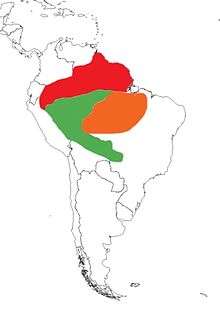Trumpeter (bird)
The trumpeters are a family of birds restricted to the humid forests of the Amazon and Guiana Shield in South America. They are named for the trumpeting or cackling threat call of the males.[1] The three species resemble chickens in size; they measure 45 to 52 centimetres (18 to 20 inches) long and weigh 1 to 1.5 kg (2.2 to 3.3 lb).[1] They are rotund birds with long necks and legs and curved bills[2] and a hunched posture.[3] Their heads are small, but their eyes are relatively large, making them look "good-natured". The plumage is soft, resembling fur or velvet on the head and neck. It is mostly black, with purple, green, or bronze iridescence, particularly on the wing coverts and the lower neck. In the best-known taxa the secondary and tertial flight feathers are white, grey, or greenish to black, and hairlike, falling over the lower back, which is the same colour. These colours give the three generally accepted species their names.[1]
| Trumpeters | |
|---|---|
_RWD.jpg) | |
| Grey-winged trumpeter, Psophia crepitans | |
| Scientific classification | |
| Kingdom: | Animalia |
| Phylum: | Chordata |
| Class: | Aves |
| Order: | Gruiformes |
| Family: | Psophiidae Bonaparte, 1831 |
| Genus: | Psophia Linnaeus, 1758 |
| Species | |
|
3–8, see text | |
 | |
| Approximate distribution of grey-winged (red), pale-winged (green) and dark-winged trumpeter (orange). The ranges are separated by large rivers. | |
Taxonomy and systematics
Traditionally only three species of trumpeters have been recognised.[4] In 2008 a review of the morphology of the dark-winged trumpeter resulted in the recommendation of splitting it into three species.[5] In 2010 a review of the phylogeny and biogeography of all members of the family resulted in a total of 8 species, including two in the grey-winged trumpeter complex, two in the pale-winged trumpeter complex, and four in the dark-winged trumpeter complex.[6]
- Grey-winged trumpeter, Psophia crepitans
- Grey-winged trumpeter, Psophia (crepitans) crepitans
- Napo trumpeter, Psophia (crepitans) napensis
- Ochre-winged trumpeter, Psophia (crepitans) ochroptera
- Pale-winged (or white-winged) trumpeter, Psophia leucoptera
- White-winged trumpeter, Psophia (leucoptera) leucoptera
- Dark-winged trumpeter, Psophia viridis
- Green-winged trumpeter, Psophia (viridis) viridis
- Brown-winged trumpeter, Psophia (viridis) dextralis
- Dark-winged trumpeter, Psophia (viridis) obscura
- Psophia (viridis) interjecta – should possibly be merged with dextralis.[5]
Behaviour and ecology
Trumpeters fly weakly but run fast; they can easily outrun dogs.[1] They are also capable of swimming across rivers.[3] They spend most of the day in noisy flocks, sometimes numbering more than 100, on the forest floor.[1] They feed on fallen fruit (particularly fruit knocked down by monkeys). They also eat a small amount of arthropods, including ants and flies,[1] and even some reptiles and amphibians.[3] At night they fly with difficulty into trees to roost 6 to 9 metres (20 to 30 ft) above the ground.[1]
Trumpeters nest in a hole in a tree or in the crown of a palm tree. They lay 2 to 5 eggs with rough, white shells, averaging about 76 grams (2.7 ounces).[1] In the pale-winged trumpeter and the grey-winged trumpeter, groups of adults care for a single clutch.[1][7]
Relationship with humans
Trumpeters are often used as "guard dogs" because they call loudly when alarmed,[1] become tame easily, and are believed to be adept at killing snakes. One source states their skill at hunting snakes as a fact,[3] and the nineteenth-century botanist Richard Spruce gave an account of the friendliness and snake-killing prowess of a tame grey-winged trumpeter. For these reasons, Spruce recommended that England import trumpeters to India.[8] However, another source says this prowess is "reputed".[9]
References
- Holyoak, David; Colston, P. R. (2003). "Trumpeters". In Perrins, Christopher (ed.). The Firefly Encyclopedia of Birds. Firefly Books. p. 213. ISBN 1-55297-777-3.
- Archibald, George W. (1991). Forshaw, Joseph (ed.). Encyclopaedia of Animals: Birds. London: Merehurst Press. p. 98. ISBN 1-85391-186-0.
- Hilty, Steven L.; Brown, William L. (1986). A Guide to the Birds of Colombia. Princeton University Press. p. 134. ISBN 0-691-08371-1. Retrieved 2008-09-19.
- Remsen, J. V., Jr., C. D. Cadena, A. Jaramillo, M. Nores, J. F. Pacheco, J. Pérez-Emán, M. B. Robbins, F. G. Stiles, D. F. Stotz, and K. J. Zimmer. 8 November 2011. A classification of the bird species of South America. Archived 2009-03-02 at the Wayback Machine South American Classification Committee
- Oppenheimer and Silveira. 2009. A taxonomic review of the Dark-winged Trumpeter Psophia viridis (Aves: Gruiformes: Psophiidae). Papéis Avulsos de Zoologia 49(41): 547‑55
- Ribas, Aleixo, Nogueira, Miyaki and Cracraft. 2012. A palaeobiogeographic model for biotic diversification within Amazonia over the past three million years. Proceedings of the Royal Society B: Biological Sciences 279: 681-689
- Hilty, Steven L. (2003). Birds of Venezuela. Princeton University Press. pp. 279–280. ISBN 0-691-09250-8.
- Spruce, Richard (1908). Alfred Russel Wallace (ed.). Notes of a Botanist on the Amazon & Andes. vol. i. Macmillan. p. 340. Retrieved 2008-09-15.
- Meyer de Schauensee, Rodolphe (1970). A Guide to the Birds of South America. Livingston Publishing Co. ISBN 0-87098-027-0.
External links
| Wikimedia Commons has media related to Psophiidae. |
- Trumpeter videos on the Internet Bird Collection